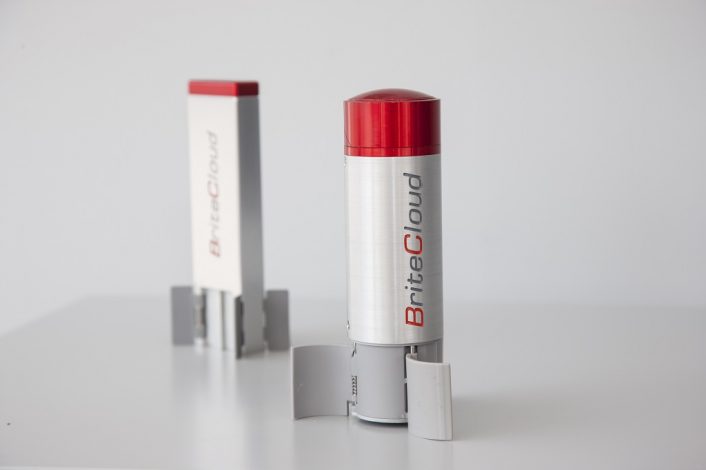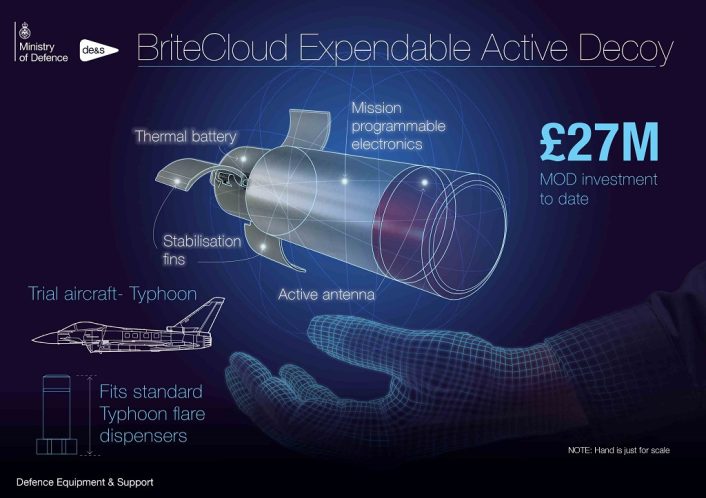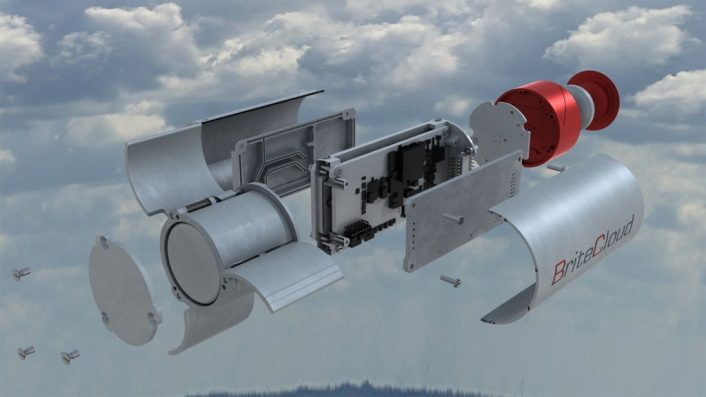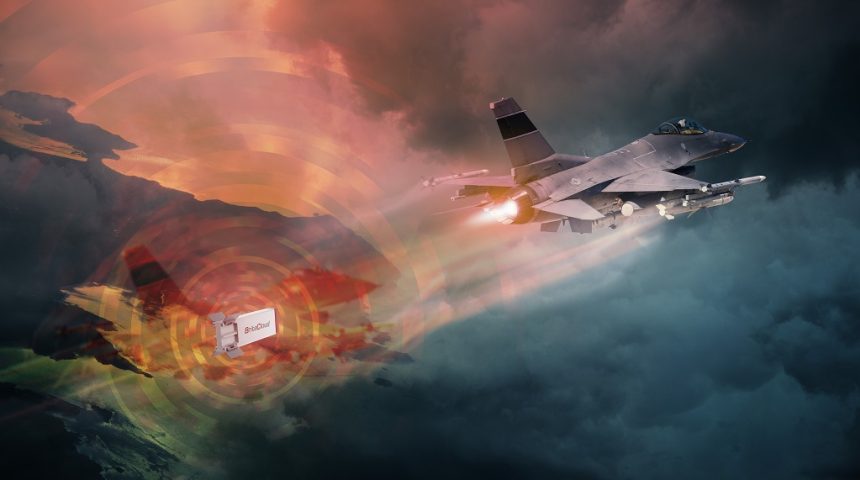BriteCloud is the first expendable DRFM decoy that can be employed like standard chaffs and flares, differentiating from the more common towed decoys.
As the radar and missile technology evolves, so must the countermeasures needed to defeat them. One of the most recent and effective technologies used to counter these threats is the Digital Radio Frequency Memory (DRFM) technology, as we mentioned last year in our article about the digital evolution of Electronic Warfare (EW). DRFM is the technology behind Leonardo’s BriteCloud Expendable Active Decoy (EAD), the first countermeasure of this kind.
Today, military aircraft face a new highly complex threat environment because of all the new technologies that are being developed. Modern SAM (Surface to Air Missile) systems, which can be both highly mobile and highly maneuverable, can present a lethal threat if not adequately taken into consideration. Even older systems, which over time might also been retrofitted with modern electronics, can still put an aircraft in grave danger. The threat gets bigger if we also consider the integration of Electronic Counter-CounterMeasures (ECCM) in the newer systems, designed to defeat the countermeasures, like chaffs, flares and jammers, employed by an aircraft.
What is BriteCloud
BriteCloud is a battery powered, self-contained cartridge that provides an off-board jamming capability – hence the term “active” – that can be dropped like the classic chaffs and flares – hence the term “expendable” -, creating a large distance between the aircraft and the decoy so the missile and its shrapnel miss completely the aircraft. According to Leonardo, BriteCloud has the capability to defeat the majority of RF-guided surface-to-air and air-to-air threat systems, including the ones that rely on the “home-on-jam” guidance (when the missile targets the jamming signal, dangerous especially for aircraft equipped only with an internal or podded jammer).
After BriteCloud is ejected, it starts to search for priority threats, collecting the incoming radar pulses and cross-referencing them against a pre-programmed threat library. Upon finding a match, BriteCloud’s on-board computer applies its advanced algorithms to simulate a “false target” so accurate that the threat system cannot detect the deception and distinguish it from the real aircraft. This happens because, as mentioned by Leonardo, the decoy is able provide both Doppler and range obscuration with range and velocity “gates” that confuse the ECCM systems.
BriteCloud is what is known as a “second generation” expendable active decoy, which differs from the first generation decoys, generically called also towed decoys, developed towards the end of the Cold War and reliant on a cable that connects them to the aircraft so they can keep the required distance and also receive data and power for the jamming signal. BriteCloud, the first second generation expendable active decoy to have been proven in live trials against advanced threats, is a project developed by Leonardo’s facilities in Luton (UK).
Leonardo is currently the only company which succeeded to sufficiently miniaturize the DRFM technology to the point where it can be launched from a standard 55 mm chaff and flare dispenser (“the size of a drinks can”, as the company described it). With these characteristics, BriteCloud requires minimal platform integration as it just needs to be loaded in the chaff/flare dispensers. Following the successful tests of the 55 mm BriteCloud round, called BriteCloud 55, Leonardo developed an even smaller variant called BriteCloud 218 which can fit the 2”x1”x8” US-made chaff/flare dispensers.

Since there is no need for extensive integration works, the system presents a significantly lower acquisition and sustainment cost. BriteCloud has been extensively tested on various platforms including the Tornado, Typhoon, Gripen, F-16 Fighting Falcon and even the MQ-9 Reaper RPAS (Remotely Piloted Air System). Leonardo is currently in discussion with several countries to integrate BriteCloud also on other unspecified platforms. The Royal Air Force became the first to field this new countermeasure in 2018.
DRFM is considered the “gold standard” of protection against radar-guided surface-to-air and air-to-air missiles. Here is a brief definition of this technology that we published last year and that Leonardo’s experts confirmed as an accurate description of DRFM:
“DRFM systems provide a more complex approach to EW protection by modifying the radar signal to create false targets. This involves the reception of a radar signal that is digitized processed and altered in real time, and then converted back to analogue and retransmitted. The system has to avoid signal degradation and keep the altered signal coherent with the source of the original signal. DRFM is highly effective in jammers, for an instance. Described in simple terms, the system digitizes the received signal and stores a coherent copy in digital memory, replicating, adjusting and retransmitting it when needed. Since this is a coherent representation of the original signal, the adversary’s radar will not be able to distinguish it from other legitimate signals and will recognize it as a real target. DRFM can be used to create false range targets both behind (reactive jamming) and ahead of (predictive jamming) the asset that it’s protecting.”
BriteCloud is not the only application of Leonardo’s DRFM technology, as its “family” also includes the Compact Jamming System (CJS) and SPEAR EW. The CJS is mostly known for its most advanced application, the Terma Electronic Combat Integrated Pylons System (ECIPS) used by many European F-16 operators. This pylon allows F-16 users who want to equip their platforms with a persistent, high-powered, modern defensive jamming capability to avoid losing a weapons station, as ECIPS is essentially a modified F-16 wing pylon and thus retains its MAU-12 bomb rack. Previously, the only way to install an external jammer was by using a podded solution, like the ALQ-131, usually found on the centerline station. The installation of CJS does not require further modifications as it is fully integrated in the already operational baseline ECIPS/ECIPS+.
The difference with BriteCloud is that it is an expendable countermeasure designed for a standard chaff/flare dispenser and this provides a key benefit as by dropping away, BriteCloud creates a large miss distance between itself and the aircraft and solves the challenge of the ‘home-on-jam’ capabilities that many modern missiles employ, as we already mentioned. Even if it has less power than a traditional on-board jammer, the power on-board the BriteCloud round is more-than sufficient to protect the aircraft from an incoming missile, lasting for a set amount of time to offer protection as it falls away from the aircraft. Leonardo noted also that BriteCloud can be used by itself as an RF protection capability as well as a complement to on-board jamming capabilities like an On-Board-Jammer such as the ECIPS/CJS or a Towed Radar Decoy (TRD).
SPEAR EW is the fruit of a new collaboration with MBDA to integrate Leonardo’s miniaturised DRFM technology into a SPEAR weapon system, allowing it to act as a stand-in jammer for Suppression of Enemy Air Defenses (SEAD)/Destruction of Enemy Air Defenses (DEAD) missions. As we reported earlier this year, the RAF already selected the standard SPEAR 3 as the primary air-to-ground weapon for British F-35s. The new variant will act as a significant force multiplier and greatly increase the survivability of aircraft.
Some history background
BriteCloud was first announced in 2013 by Selex ES, one of the companies that made up the larger Finmeccanica group (before it was later renamed Leonardo in 2017) as the technological successor of older systems like the Towed Radar Decoys (TRD). The concept for BriteCloud emerged from the company’s close working relationship with UK’s Defence Science and Technology Laboratory (DSTL) and the Royal Air Force, which expressed the need for a sophisticated jamming capability in a standard expendable format.
Just a year later, in 2014, BriteCloud was first tested with an unspecified fighter aircraft releasing fully functional decoys while being tracked by a ground-based fire-control radar. The decoy performed as expected, breaking the radar lock on the aircraft and “forcing” the radar to follow the decoy until it impacted the ground. In 2015, Saab was the first to offer BriteCloud as an option on its aircraft, following the successful testing on the Gripen which saw the aircraft performing three flights and three releases of the new decoy in Sweden.
During the same year, the RAF 41 Test and Evaluation Squadron carried out its initial evaluation of BriteCloud in the USA, dropping an unspecified number of fully functional decoys launched from a Tornado GR4 as it was tracked by ground-based advanced RF threat systems. The test proved the maturity of BriteCloud’s DRFM technology against the modern threats that could be encountered by pilots today and prompted the UK Ministry of Defence to purchase in 2016 a significant number of the decoys to allow the RAF to further evaluate BriteCloud’s protective effect with its fleet of Tornado jets and develop a “concept of operations” (CONOPS) for the technology.

In 2017, the RAF established the new Rapid Capability Office (RCO), with Leonardo as one of the partners, and BriteCloud became the first joint project aimed at further developing the DRFM technology while planning also a new “third generation” EAD. The RCO, Leonardo and the RAF worked then through a new test campaign in the USA which resulted in the go-ahead for operational service of BriteCloud on the Tornado GR4 in 2018.
In the meanwhile, the BriteCloud 218 variant was tested for the first time on a Royal Danish Air Force F-16A-MLU Fighting Falcon. As already mentioned, BriteCloud 218 fitted directly into the F-16’s standard AN/ALE-47 Airborne Countermeasures Dispenser System without the need for integration work. During the test, the Viper deployed the decoy after it was locked-onto by a real radar-guided surface to air missile targeting system, allowing Leonardo to collect essential performance data needed to complete the adaptation of the technology in the 2”x1”x8” format, which is about half the size of the original BriteCloud 55.
Obviously, transport aircraft and helicopters are also threatened by modern radars and missiles, so Leonardo announced in 2019 the development of a more powerful decoy called BriteCloud 55-T. The decoy still has the same dimensions of BriteCloud 55 but, because aircraft like the C-27J Spartan, the C-130 Hercules and the A400M have a larger Radar Cross Section (RCS), a higher power output was needed to create a larger false target which would lure the threats away. This time BriteCloud won’t have a dedicated 2”x1”x8” variant, but it will simply use an adapter magazine to deploy the round 55 mm decoy from square dispensers. BriteCloud 55-T is now near to completion of development and final preparation for production, according to Leonardo.
During the same year, as we reported here at The Aviationist, the Tornado GR4 was retired, so the RAF started working to certify BriteCloud 55 also on the Typhoon FGR4 as part of the new capabilities of Project Centurion. The testing was done once again by the 41 Test and Evaluation Squadron, which released 33 BriteCloud rounds against a range of representative threats.
New interests and applications
As you might expect, such an advanced technology gathered a lot of interest even outside of Europe. The BriteCloud system, in fact, got the attention also of the United States Department of Defense, which has selected the decoy to be evaluated under the US Foreign Comparative Testing (FCT) programme. The FCT is focused on finding, evaluating and eventually fielding important products and technologies produced by US allies that satisfy the needed requirements more quickly and economically that US-made ones.
The BriteCloud FCT will be performed by the Air National Guard (ANG), which will evaluate the BriteCloud 218 round on the F-16C. The decoy will be tested in a variety of challenging scenarios to provide a high level of confidence in the performance of the system and to demonstrate the ability to enhance F-16 survivability in modern scenarios. BriteCloud might end up replacing or complementing the AN/ALE-50 “Little Buddy” Towed Decoy System currently used by the Vipers.
A new application for this miniaturized technology comes from the UAV (Unmanned Aerial Vehicle) world which, due to their limited dimensions, require compact and light-weight systems. Because of these restrictions, UAV were never equipped with defensive systems. However, the increasing presence of UAVs in conflict areas, even when advanced air defences are present, highlighted a growing need to protect the high-value unmanned aircraft from modern radar-guided threats as they carry out their valuable missions.

Because of this, as we already reported, General Atomics Aeronautical Systems developed in 2020 the new Self-Protection Pod for the MQ-9 Reaper RPAS, equipped with the AN/ALR-69A(V) RWR, AN/AAQ-45 Distributed Aperture Infrared Countermeasure (DAIRCM) System and AN/ALE-47 Countermeasures Dispenser System. Among the countermeasures that were loaded in the ALE-47 there was BriteCloud 218.
The MQ-9 became the first RPAS to employ EADs like BriteCloud, with a test campaign that saw the Reaper releasing a number of inert decoys during carriage and release trials, which are designed to ensure that the decoy can be dispensed safely. Further tests with live rounds are being discussed to demonstrate BriteCloud’s effectiveness with the MQ-9 before the Self-Protection Pod is eventually fielded. Should BriteCloud pass the FCT successfully as expected by the company, the decoy would be open for acquisition across the US Armed Forces and it could be an option for operational US Reaper drones.
The Reaper, however, won’t be the first RPAS to deploy live EADs, as in early 2021 the German Armed Forces successfully released live BriteCloud 218 decoys from an Airbus RPATS (Remotely Piloted Air Target System) test platform. The decoy allowed the RPATS to evade Semi-Active Radar Homing (SARH) missiles during what Leonardo understands was a live fire event. The German trial marked also the first time BriteCloud has been launched from an RPATS platform specifically.
Some unconfirmed rumors reported that BriteCloud could have been eyed for integration on the F-35 Lightning II. While the company could not confirm as it is not aware of these reports, they stated that the integration is possible on any aircraft which can accommodate 55mm or 2x1x8 inch expendables, with no further aircraft modification required. Details about the F-35’s expendable countermeasures are classified, however the few unclassified details mention that the aircraft should be able to carry both 1x1x8 inch and 2x1x8 inch expendables, which opens to the possibility of BriteCloud 218 evaluated in the future on the 5th gen aircraft, should the requirement arise.
In the meanwhile, Leonardo is still working to improve BriteCloud, as the company has plans to allow in-flight pre-ejection reprogramming of BriteCloud for the threat that it is about to face via a smart interface, once this capability becomes operationally available in frontline chaff/flare dispensers.
The Aviationist would like to thank Leonardo’s spokesperson John Stevenson and the company’s team of experts for the help provided in the preparation of this article, while making sure also that it would not compromise sensitive information that would preclude the safety of the aircraft and crews employing this advanced technology.









